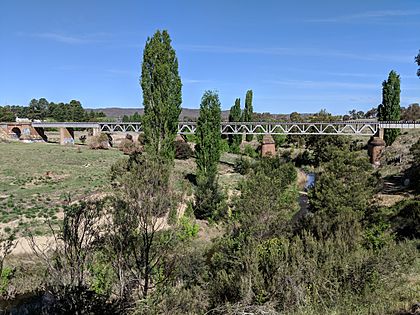Queanbeyan railway bridges over Queanbeyan and Molonglo Rivers facts for kids
Quick facts for kids Queanbeyan rail bridges |
|
|---|---|

Queanbeyan River railway bridge
|
|
| Coordinates | 35°20′33″S 149°13′54″E / 35.3424°S 149.2317°E (QR) 35°20′14″S 149°19′09″E / 35.3371°S 149.3191°E (MR) |
| Carries | Bombala railway line |
| Crosses | |
| Locale | Queanbeyan, Queanbeyan-Palerang Region, New South Wales, Australia |
| Other name(s) | Burbong bridge (Molonglo River Bridge) |
| Owner | RailCorp |
| Characteristics | |
| Design | Warren truss bridge |
| Material | Steel |
| Longest span | 90 feet (27 m) |
| Number of spans |
|
| History | |
| Construction begin | 1926 |
| Construction end | 1927 |
| Construction cost | A£19,000 |
| Official name: Queanbeyan rail bridges over Queanbeyan and Burbong Rivers | |
| Type: | State heritage (complex / group) |
| Designated: | 2 April 1999 |
| Reference #: | 1052 |
| Type: | Railway Bridge/ Viaduct |
| Category: | Transport - Rail |
The Queanbeyan railway bridges are two special bridges in New South Wales, Australia. They are important because they are listed as heritage sites. These bridges carry the Bombala railway line, which is a train track.
One bridge crosses the Queanbeyan River in Queanbeyan. The other bridge crosses the Molonglo River near a place called Burbong, which is now Carwoola. Both bridges were built between 1926 and 1927. They are owned by RailCorp, a government group in New South Wales. These two bridges were added to the New South Wales State Heritage Register on April 2, 1999.
Contents
How the Bridges Were Built
The first bridges were built by a company called Johnston & Co. This happened between 1885 and 1887. They were part of extending the railway line from Bungendore to Michelago, passing through Queanbeyan.
The Molonglo River bridge was finished in May 1886. The Queanbeyan River bridge was finished in July 1887. Both bridges opened for trains in September 1887.
Original Design
The first bridges were made of strong hardwood timber. They had arched wooden beams and rested on brick supports and stone foundations. The Molonglo River bridge had four sections, and the Queanbeyan River bridge had five sections. Each section was about 24 meters (80 feet) long. The stone for the foundations came all the way from quarries in Pyrmont, near Sydney.
During the building of the Queanbeyan River bridge, a temporary bridge was put up. People at the time said it was the biggest temporary railway bridge ever built in New South Wales!
Rebuilding for Heavier Trains
The bridges were completely rebuilt between 1926 and 1927. This cost about A£19,000. The builders were able to use the original foundations, which saved some work.
The new bridges were made of steel and used a design called a Warren deck steel truss. This design is very strong. Each bridge had four steel sections on the sides. The main part of the Queanbeyan River bridge had three sections, and the Molonglo River bridge had two sections. These main sections were about 27 meters (90 feet) long.
Even though the old timber was replaced, it was in "a remarkable state of preservation." This means it was still in great condition! The upgrade allowed much heavier trains to use the railway line.
The Molonglo River bridge is sometimes called the Burbong bridge. Burbong is an old name for the area where the bridge is located.
Why These Bridges Are Special
The Queanbeyan rail bridges are listed on the New South Wales State Heritage Register. This means they are important parts of history. They were added to the list on April 2, 1999.
Historical Importance
These bridges are special because they are connected to the Cooma Railway, which opened in 1887. It's also rare that the original foundations from the 1880s were reused for the new bridges in 1926.
Unique Design
The Warren deck truss design used for these bridges is quite rare for railway bridges in New South Wales. There are only four other railway sites in the state that have this type of bridge structure. This makes the Queanbeyan bridges unique and important to study.

